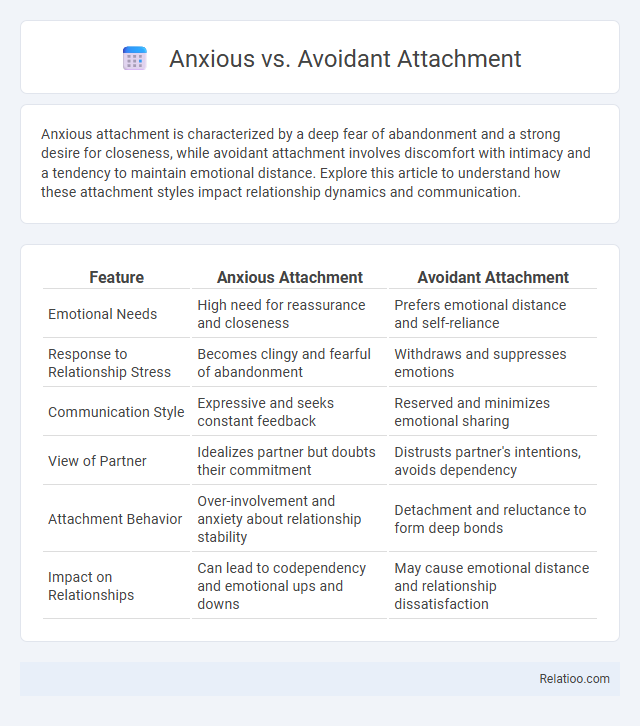Anxious attachment is characterized by a deep fear of abandonment and a strong desire for closeness, while avoidant attachment involves discomfort with intimacy and a tendency to maintain emotional distance. Explore this article to understand how these attachment styles impact relationship dynamics and communication.
Table of Comparison
| Feature | Anxious Attachment | Avoidant Attachment |
|---|---|---|
| Emotional Needs | High need for reassurance and closeness | Prefers emotional distance and self-reliance |
| Response to Relationship Stress | Becomes clingy and fearful of abandonment | Withdraws and suppresses emotions |
| Communication Style | Expressive and seeks constant feedback | Reserved and minimizes emotional sharing |
| View of Partner | Idealizes partner but doubts their commitment | Distrusts partner's intentions, avoids dependency |
| Attachment Behavior | Over-involvement and anxiety about relationship stability | Detachment and reluctance to form deep bonds |
| Impact on Relationships | Can lead to codependency and emotional ups and downs | May cause emotional distance and relationship dissatisfaction |
Understanding Attachment Theory
Attachment theory explains how early relationships with caregivers shape your emotional bonds and coping mechanisms. Anxious attachment creates a strong desire for closeness but fear of abandonment, while avoidant attachment leads to maintaining distance and emotional self-reliance. Separation anxiety specifically involves distress when separated from attachment figures, highlighting the intensity of emotional dependence in these attachment styles.
What Is Anxious Attachment?
Anxious attachment is characterized by a heightened fear of abandonment and intense desire for closeness, often leading to clingy or needy behaviors in relationships. Individuals with anxious attachment experience heightened emotional sensitivity and may interpret ambiguous social cues as rejection, causing distress and insecurity. This attachment style often develops from inconsistent caregiving during early childhood, influencing adult interpersonal dynamics and emotional regulation.
Characteristics of Anxious Attachment
Anxious attachment is characterized by a strong fear of abandonment, emotional dependency, and heightened sensitivity to rejection, often leading to clingy or overly demanding behavior in relationships. Individuals with this attachment style frequently seek constant reassurance and struggle with trust, resulting in mood swings and anxiety about their partner's availability. This contrasts with avoidant attachment, marked by emotional distance and self-reliance, and separation anxiety, which involves extreme distress when separated from attachment figures.
What Is Avoidant Attachment?
Avoidant attachment is a style characterized by emotional distance and self-reliance, where individuals often suppress feelings and avoid closeness to protect themselves from potential rejection. It contrasts with anxious attachment, which involves a strong fear of abandonment and desire for constant reassurance. Understanding your avoidant attachment can help you recognize patterns in relationships and improve emotional intimacy over time.
Characteristics of Avoidant Attachment
Avoidant attachment is characterized by a strong desire for independence and emotional distance, leading individuals to suppress their feelings and avoid closeness in relationships. People with this attachment style often appear self-reliant, struggle with trust, and resist depending on others to protect themselves from potential rejection or abandonment. In contrast to anxious attachment, avoidant individuals downplay the importance of intimacy and may exhibit discomfort with emotional expression, while separation anxiety typically involves intense distress over real or perceived separation from attachment figures.
Key Differences Between Anxious and Avoidant Attachment
Anxious attachment is characterized by a strong desire for closeness paired with fear of abandonment, leading to clingy and dependent behaviors. Avoidant attachment involves emotional distancing and discomfort with intimacy, resulting in self-reliance and suppression of attachment needs. Separation anxiety primarily reflects intense distress during separation from attachment figures, often linked to anxious attachment but distinct from avoidant patterns.
Impact of Attachment Styles on Relationships
Anxious attachment is characterized by fear of abandonment and heightened sensitivity to rejection, leading to clinginess and emotional dependency in relationships. Avoidant attachment results in emotional distance and difficulty trusting others, often causing partners to feel neglected or unimportant. Separation anxiety, often linked with these attachment styles, intensifies distress during physical or emotional separation, undermining relationship stability and communication.
Common Triggers for Anxious and Avoidant Individuals
Common triggers for anxious attachment include perceived rejection, inconsistent communication, and fear of abandonment, leading to heightened emotional sensitivity and reassurance-seeking behaviors. Avoidant attachment is often triggered by closeness demands, loss of autonomy, and emotional vulnerability, resulting in withdrawal and suppression of feelings. Both attachment styles experience stress in uncertain or unpredictable relationship dynamics, intensifying separation anxiety symptoms.
Strategies to Manage Anxious and Avoidant Attachment
Managing anxious attachment involves practicing self-soothing techniques such as mindfulness meditation, journaling emotions, and establishing clear communication boundaries to reduce dependency and regulate emotional responses. For avoidant attachment, strategies include gradually increasing vulnerability through consistent emotional openness, seeking therapy to address fear of intimacy, and fostering safe relationship environments that encourage trust and connection. Both attachment styles benefit from developing secure relationship patterns through awareness, patience, and professional support to transform attachment behaviors and enhance relational security.
Moving Toward Secure Attachment
Anxious attachment is characterized by a fear of abandonment and excessive need for reassurance, while avoidant attachment involves emotional distance and reluctance to rely on others. Separation anxiety manifests as intense distress when separated from attachment figures, often linked to anxious attachment patterns. Moving toward secure attachment requires developing emotional regulation, fostering trust through consistent responsiveness, and gradually building confidence in healthy, interdependent relationships.

Infographic: Anxious vs Avoidant Attachment
 relatioo.com
relatioo.com